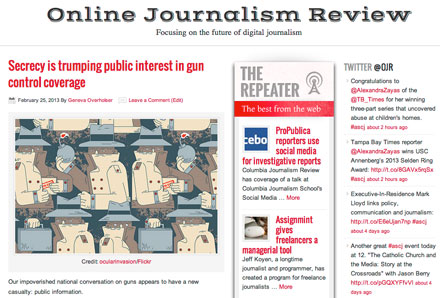
OJR opens a new chapter today with a fresh look and even more of the content you’ve come to trust. Not only that, but we’re looking to involve the greater journalism community in the discussion. We are now accepting submissions from reporters and media observers who can offer keen insight into the future of news.
But first, the look. OJR has developed a reputation for thoughtful, in-depth reporting and commentaries on the changing media landscape. That focus remains the cornerstone of our brand. Front and center you will always find one of our signature reports or commentaries, and the latest offering is a perfect example. Geneva Overholser, director of the journalism school at our host institution, USC Annenberg, raises critical questions about the nature of public interest reporting in a time when information is easier than ever to obtain but concerns over privacy threaten to muzzle discourse. Her focus is on the recent spate of government attacks on news organizations for publishing information about gun permit holders following the tragic shooting in Newtown, Conn. Overholser draws on some hard-knock experience as an old-school journalist and editor and weaves in spot-on observations about how open data is changing the business to come up with a compelling argument for openness, as painful as it may be.
The first thing you’ll probably notice that’s different, aside from a new color scheme and masthead, is that conspicuous center column. This is a new department we’re calling The Repeater. Here you will find news and views from other outlets that we think are worth passing along.
Beyond the website, we recently launched a Facebook page. There, and on Twitter, you will find more of the stuff we’re paying attention to that we didn’t have time to include in The Repeater.
With these advances, we will be able to build on our continuing commitment to help our readers understand and contribute to the revolution taking place in news.
And that’s where you come in. Defining online journalism has never been more interesting. Is it about the ever more important role of data? The burgeoning reporting potential of social media? The ever-richer conversation between communities and journalism? The changing role of professionals amid the convergence of news platforms? We want to hear from you. Maybe you have a topic you’d like to see discussed, or maybe you have an article to pitch. Either way, we want to hear from you.
If you have a question, a story idea, or you’re interested in contributing, send your pitch to editor[at]ojr[dot]org. Or feel free to just leave a comment below to share your thoughts about this new direction for OJR.
As a large, vibrant and diverse undergraduate and graduate School of Journalism, USC Annenberg is grappling with all these questions. They play out in our multiple newslabs, they inform our teaching (and learning!), they determine the nature of our research. We will continue to draw on all these experiences with contributions from our faculty, staff and students, and we hope you’ll join us.








